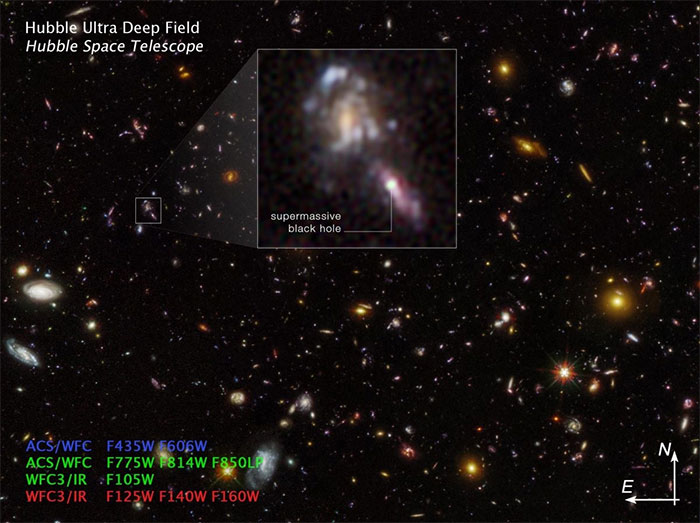NASA captures the 'immortal god of death' of the universe
Scientists have detected unusual signals resembling flashing lights, "crossing space" from where the universe began.
A team of astronomers from Stockholm University (Sweden) looked at data recorded by NASA's Hubble Space Telescope about faint galaxies born shortly after the Big Bang event that created the universe and noticed an unusual phenomenon.
These are galaxies that belong to the early universe about 13 billion years ago.

A black hole flashes in Hubble data - (Photo: NASA/ESA).
These ancient galaxies were once located about 13 billion light years from where Earth exists today, and the light that makes up their images takes a similar amount of time to reach the telescope.
This inadvertently helps us see images of the past and know what happened when the universe was young.
In this case, the strange signals Hubble picked up could help explain the puzzle: Did the galaxies come first, or did the monster black holes come first?
According to the authors, the unusual signals in the nuclei of these galaxies are their supermassive black holes, a type of black hole known as a monster black hole, but much more terrifying than the monster at the center of our galaxy.
They are the largest black holes, millions or billions of times more massive than the Sun , acting as rips in space-time that forever devour anything that passes nearby.
They are like sleeping dragons, not pulling matter continuously but only waking up and becoming active whenever something happens to pass by.
Each time they wake up to "eat", they light up like a lighthouse and then temporarily turn off . This is what causes the strange flickering light that Hubble recorded.
In the study published in the scientific journal The Astrophysical Journal Letters, the authors said they had done a thorough search and realized that there are more of these black holes than previously thought.
Many of these objects appear to be larger than the initial masses scientists thought they could attain in the early universe, suggesting they must have been very large when they formed or evolved rapidly.
The authors suggest that this size and prevalence suggests that black holes - the nuclei of galaxies - existed before the first galaxies formed.
They may have been formed by the collapse of massive, primordial stars during the first billion years of cosmic time.
It was a very large, very hot and short-lived star, enough to create a large black hole when it died, not the small stellar mass black holes of today.
Alternatively, they can also form directly from collapsing gas clouds, the merger of massive stars.
Another interesting scenario is that they are the result of a merger of a type of primordial black hole, formed just seconds after the Big Bang.
- 'God's hand' in the universe
- NASA captures a star image
- The 3 biggest hypotheses about the death of the universe
- Summary of the best news of the week 04/03/2017
- NASA opens the door to document 140,000 stunning images of the universe for the whole world
- This is how humans did to be ... immortal in the 1960s
- NASA captures 'future image' of Sun exploding and dying
- 4 apocalyptic scenarios of the universe
- Giant black mark on the surface of the Sun.
- 8 ways to become immortal in ancient myths
- As early as 2.8 billion years the new universe dies, don't be too afraid
- Found the gene still active after our bodies die
 Van Allen's belt and evidence that the Apollo 11 mission to the Moon was myth
Van Allen's belt and evidence that the Apollo 11 mission to the Moon was myth The levels of civilization in the universe (Kardashev scale)
The levels of civilization in the universe (Kardashev scale) Today Mars, the sun and the Earth are aligned
Today Mars, the sun and the Earth are aligned The Amazon owner announced a secret plan to build a space base for thousands of people
The Amazon owner announced a secret plan to build a space base for thousands of people The nearest black hole discovered is only 150 light years from Earth
The nearest black hole discovered is only 150 light years from Earth  New discovery of the oldest black hole in the universe
New discovery of the oldest black hole in the universe  The Black Pyramid and the tragedy of deep oblivion: A thousand years later, still no escape from the tragedy of tomb raiding
The Black Pyramid and the tragedy of deep oblivion: A thousand years later, still no escape from the tragedy of tomb raiding  Exploring the 'Black Box of the Earth' project: A device that records the process of human extinction
Exploring the 'Black Box of the Earth' project: A device that records the process of human extinction  Finding the mysterious 'monster' that is making the universe expand
Finding the mysterious 'monster' that is making the universe expand  Why do images of black holes appear to be burning from the outside?
Why do images of black holes appear to be burning from the outside? 